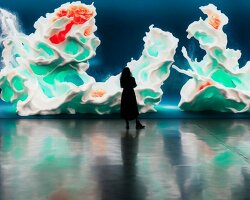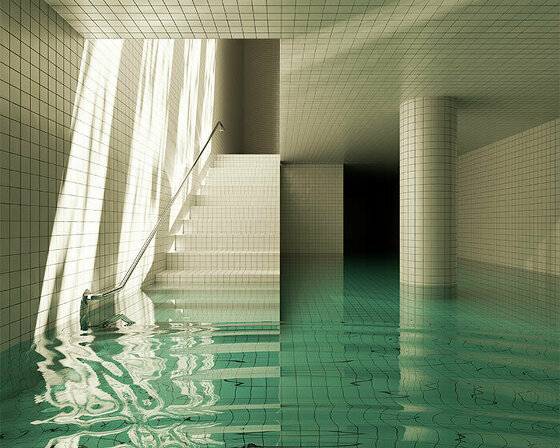interview: art d’égypte/culturvator presents forever is now 03
Following two successful editions with artworks by SpY and JR, Forever is Now returns to Egypt this year with a third edition running from October 26 until November 18, 2023. This annual event, launched by Nadine Abdel Ghaffar, is the first and only contemporary art exhibition taking place at the Pyramids of Giza, a 4,500-year-old UNESCO World Heritage site, and its surrounding plateau. Bringing together global artists to reflect on the enduring legacy of one of humanity’s most compelling and mysterious structures, the exhibition traces the continuity of themes that stretch from our ancient past to the present day while paying homage to the ingenuity and reflections of human civilization and art.
Former art advisor turned curator Nadine Abdel Ghaffar established Forever is Now in 2021, fundamentally changing Egypt’s cultural landscape since then. Born in Alexandria to French and Egyptian parents, Nadine leveraged her mixed background to launch herself into the art world, kickstarting her journey with a fascination for Alexandria — a city where art, architecture, and archaeology take center stage. ‘I have merged all three into what Art D’Égypte originally was,‘ she tells designboom.
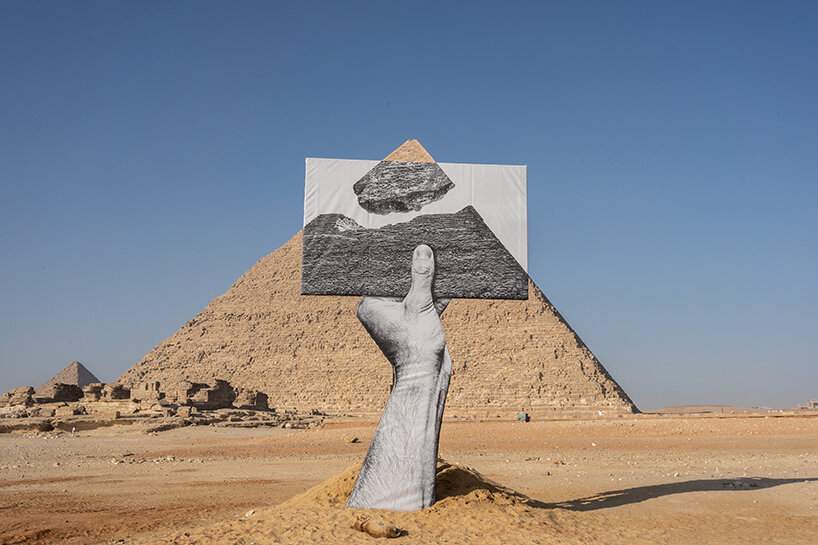
Greetings from Giza (2021) by JR | image © Hesham Alsaifi
Nadine established Art D’Égypte in 2016 as a multi-disciplinary platform to support Egyptian arts and cultural initiatives. Since 2021, the firm led the annual Forever is Now exhibition at the Pyramids of Giza, turning itself into a powerhouse with growing international recognition, year on year. The numbers speak for themselves: Over a million visitors combined, three million in global reach, 1,800+ international press coverages, and a billion organic views. To consolidate and support Art D’Égypte’s expanding initiatives and influence, the curator founded Culturvator in 2023 as a global consultancy where public and private entities unite to promote culture across diverse disciplines, including visual arts, film, heritage, design, and music. Read on as designboom offers a peek into this year’s exciting program while speaking to Nadine Abdel Ghaffar, who traces her journey into the art scene and reflects on the cultural impacts ignited by her initiatives.
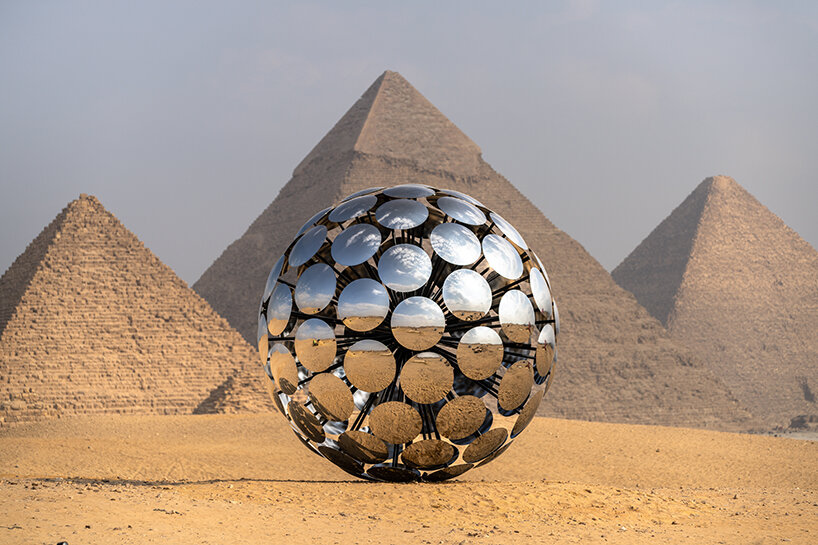
ORB Under the Same Sun (2022) by SpY | image courtesy Art D’Égypte/Culturvator
how forever is now’s third edition sets itself apart
During our talk, Nadine Abdel Ghaffar points out how this year’s edition sets itself apart by highlighting the concept of ‘play’ to transform the Giza Plateau into a space of serendipity, chance, and experimentation, with sculptural artworks inviting viewers to engage with them. By becoming creators of their own experience and altering the outcome of each work, visitors blur the line between artist and viewer in a playground of possibilities. ‘It is a more engaging experience this year, no longer just a dialogue between the artists and the pyramids. It is now a trilogy between artist, viewer, and the ancient site,‘ she shares with us.
Beyond this interactive trilogy, Forever is Now 03 also reveals a special art and design festival at a second UNESCO-listed heritage site: the Salah al-Din Citadel. Running between October 22 and November 4, 2023, the festival, entitled If The Walls Could Talk, presents another instance where Art D’Égypte/Culturvator rethinks a historical space through contemporary art and culture. Essentially, If the Walls Could Talk invites the viewer to peel back the layers of time and explore the untold stories woven into the Citadel. Paintings, sculptures, and installations take over the historic space, each capturing the hidden essence of those narratives and what lies beneath the surface. In her curatorial statement, Nadine concludes that this year’s edition is all about looking ‘to the future while honoring our past, and staying rooted in the now.’

Inside Out photo booth installation by JR | image © Hesham Alsaifi
In line with Art D’Égypte’s global vision, the festival features three group exhibitions, combining more than 50 artists from around the world and the Middle East — namely Algeria, Bahrain, Egypt, Iraq, Kuwait, Lebanon, Palestine, Morocco, Qatar, Saudi Arabia, Sudan, Syria, Tunisia and UAE. Participating artists include Mohamed Abla, Omar Toussoun, Gisela Colon, Jean Boghossian, eL Seed, Mohamed Abouelnaga, Christian Pellizzari, Seif El Rashidi, Hamza Bounoua, Abdulrahim Sharif, Balqees Fakhro, Adel El Siwi, Souad Abdelrasoul, Mahmoud Obaidi, Diaa Azzawy, Serwan Baran, Ghadah Alkandari, Abdelrasoul Salman, Ayman Baalbaki, Abdul Rahman Katanani, Nabil Anani, Sliman Mansour, Hassan Bourkia, Youssef Ahmed, Nasser Al Turki, Shrouq Bnt Fahad, Khaled El Owais, Salah El Mur, Youssef Abdelke, Bahram Hajou, Khaled Takreti, Abdul Qader Al Rais, Fatma Lootah and more.

image © Mo4 Network
nadine abdel ghaffar’s curatorial journey
The success behind Art D’Égypte/Culturvator, and subsequently Forever is Now, boils down to Nadine’s primal vision: connecting ancient Egyptian art to that of the 21st century. ‘The whole idea behind Art D’Égypte when it started was, really, to showcase the transcendence that Egyptian artists have with their heritage,‘ she states. This transcendence materialized with a celebration of modern art and culture amid Egypt’s heritage sites — namely the Pyramids of Giza, Tahrir Square, the Salah al-Din Citadel, and the historic Mu’izz Street in the heart of Cairo.
Her vision of juxtaposing contemporary art with antiquities and heritage sites came to life in 2017, igniting the four iterations organized by Art D’Égypte. Despite being met with quizzical looks and shaking heads, the first iteration, Eternal Light (2017), at the Egyptian Museum proved highly successful. ‘It was such a big hit that we started gaining the confidence of the public sector to work together. It developed into a bigger concept: Nothing Vanishes, Everything Transforms (2018) at the Manial Palace, a whole gated space that hosted a much bigger exhibition,’ Nadine shares with designboom.

‘here have I returned’ (2021) by Sherin Guirgis | image © Hesham el Saifi
The third iteration, dubbed Reimagined Narrative (2019), was then launched at the historic Mu’izz Street in Cairo; here, Art D’Égypte invited the public to engage in discussions at an open-air theater, shedding light on its mission and prompting locals to take part in preserving their heritage. Completing the lineup is the globally-praised Forever is Now (2021) exhibition at the Pyramids of Giza, with its third edition promising exciting new works. As the curator explains, this exhibitory evolution ‘reflects my dream of taking on different challenges; I have this urge to constantly try to share knowledge with more people, especially through Culturvator — getting different projects in different areas of the region. Now that we know the drill, we’ve been through it all. I guess we have a track record that is quite important,‘

‘Ouroboros’ (2021) by Alexander Ponomarev | image © Mo4
democratizing the arts in egypt
Such a track record is powered by social engagement, a crucial practice toward democratizing the arts in Egypt, Nadine Abdel Ghaffar argues. Art D’Égypte/Culturvator’s social impact begins with exhibiting shows on publicly accessible sites. ‘Whatever exhibition we curate, we make sure to showcase it in a public space where anyone can come in. We don’t close it off to, let’s say, only art collectors. By doing so, the viewer is no longer intimidated and becomes more invested in art and culture,’ she says. In addition to expanding access, Art D’Égypte/Culturvator organizes a series of free public talks, during which international artists and renowned galleries — like Christie’s — are invited to share their insights with the art community.
Completing Art D’Égypte/Culturvator’s democratized vision is the art guides program founded in 2019, earning Nadine the support of UNESCO: ‘We have over 100 guides that graduate from our program every year. They are usually set in local universities; they get to work with artists and interact with the public. They’re empowered, they’re young people. The training program offers a certification for this kind of exposure.’

Barzakh (2201) by Moataz Nasr | image © Mo4
Building on that social dimension, we asked Nadine how new technologies could play a role in preserving and spotlighting the value of ancient art. She emphasizes the power of free digital platforms, especially in our post-COVID reality, and how they empower Art D’Égypte/Culturvator to reach an even wider audience, targeting art enthusiasts who are unable to attend the shows. This post-COVID realization even encouraged Nadine to expand her company’s digital footprint through new channels. ‘We recently subscribed to Bloomberg Connects and have an important podcast called Cultural Conversations on Spotify. We also share as much possible through our YouTube channel, Art D’Égype Official, since we do a lot of free public talks. We’re on Artsy as well!‘ she elaborates.

image © Hesham Alsaifi
‘we’re witnessing a general movement in the region’
Wrapping up our talk, Nadine Abdel Ghaffar delves into the cultural movement set forth by Art D’Égypte/Culturvator’s empowering initiatives. ‘We have incredible Egyptian artists and important galleries putting in so much effort to support these artists. I must say I am quite hopeful.’ She goes on to explain how this movement is shaping up at a regional scale — with countries like Saudi Arabia and UAE dominating the Gulf’s cultural/art scenes. To maintain this upward-moving trend, Nadine emphasizes the importance of understanding the connections tying each country in the region. ‘We have to understand that there are so many interrelationships, […] for instance, between Egypt and Saudi Arabia. And the connection begins in Ancient Egypt; Ramses III was in Saudi Arabia, and I got to discover that organically through Sultan Bin Fahad’s artworks; there were inscriptions!’ she remarks.
This connection finds its way to contemporary times, with two key figures that have redefined the value of Egyptian art: Dr. Mohammed Said Farsi — a great art patron whose collections and works went on Christie’s — and Qatari artist Sheikh Hassan Al Thani — who honored one of Farsi’s artifacts by displaying it in a museum in Qatar. Ultimately, this inter-regional connection has helped ‘shed light on and even tipped the value of modern Egyptian artists. These interactions and collaborations in the region, and those bridges that are there and have been there for many years, should be celebrated.’

French-Egyptian curator Nadine Abdel Ghaffar | image © Rofy Samuel
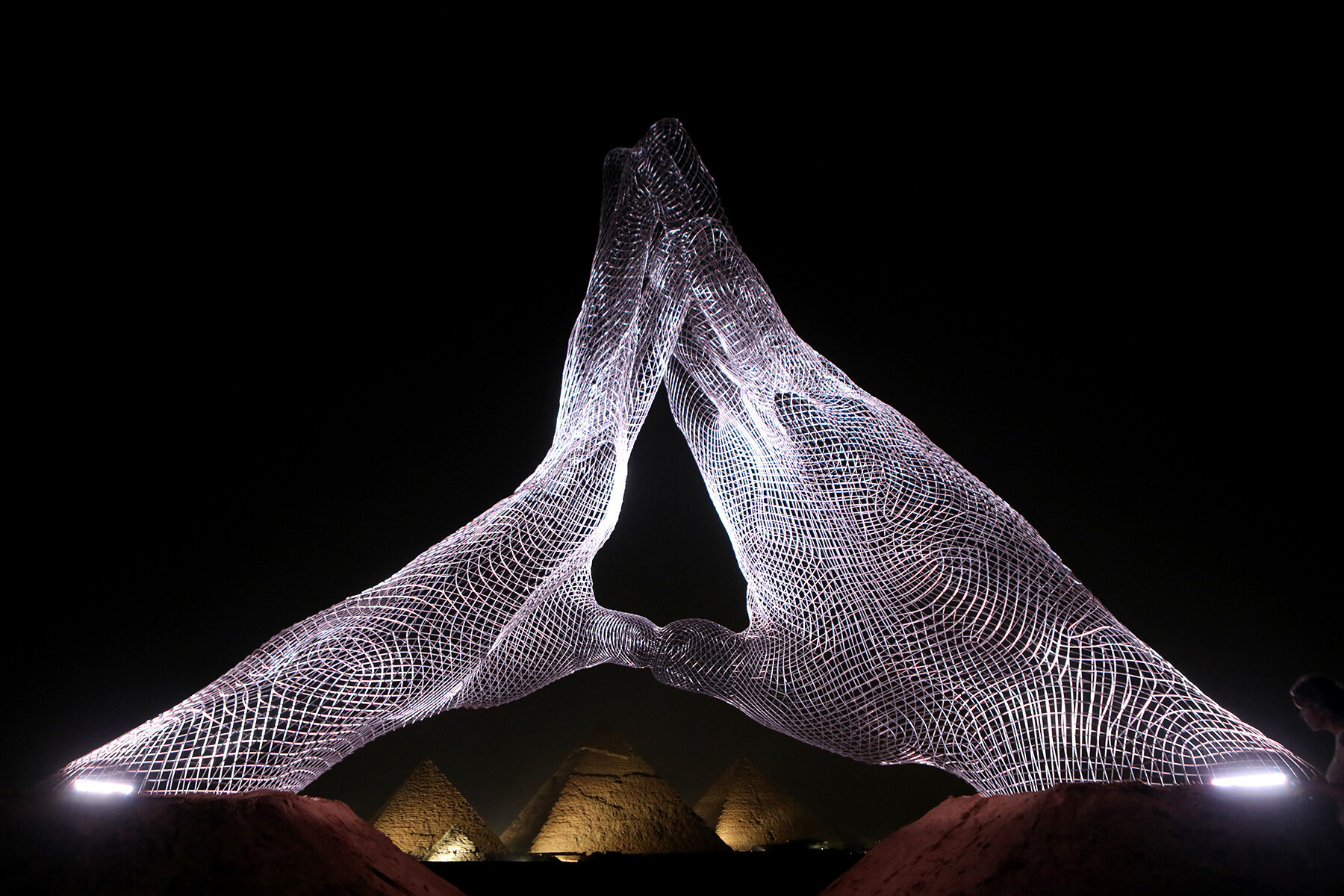
Together by Lorenzo Quinn | image © Ammar
project info:
exhibition name: Forever is Now 03
curator & interviewee: Nadine Abdel Ghaffar | @nadine_abdelghaffar.official
organized by: Art D’Égypte/Culturvator | @artdegypte
running dates: October 26-November 18, 2023
ART INTERVIEWS (119)
PRODUCT LIBRARY
a diverse digital database that acts as a valuable guide in gaining insight and information about a product directly from the manufacturer, and serves as a rich reference point in developing a project or scheme.





